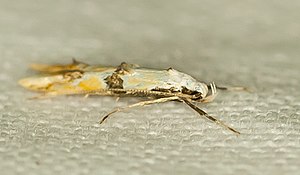Heinemannia festivella
| Heinemannia festivella | ||||||||||||
|---|---|---|---|---|---|---|---|---|---|---|---|---|

Heinemannia festivella |
||||||||||||
| Systematics | ||||||||||||
|
||||||||||||
| Scientific name | ||||||||||||
| Heinemannia festivella | ||||||||||||
| ( Denis & Schiffermüller , 1775) |
Heinemannia festivella is a butterfly fromthe grass leaf miner family (Elachistidae).
features
The moths reach a wingspan of 14 to 18 millimeters. The head shines white, the antennae are pale gray and indistinctly ringed. The thorax shines white, the tegulae are white and have a dark gray-brown spot in front. The fore wings are pale yellow and become darker distally . The costal line is dark brown and becomes paler towards the wing tip. It is interrupted at 3/4 of the forewing length by a whitish spot. A dark brown spot is in front of the middle of the wing, this extends from the costal line to the costal fold. A large clump of raised dark brown scales is opposite this spot and below the costal fold. A second dark brown spot is on the inner corner . In it there is a dark brown tuft of scales. The base of the costal line, the two dark brown spots and the tufts of scales are outlined in white. A white line is present in the apical area near the inner wing of the wing. There is a white spot on the wing tip. The fringed scales are gray-yellow, at the apex there is a light brown line. The hind wings shine pale gray.
The males of H. festivella can be distinguished from Heinemannia laspeyrella and Heinemannia albidorsella by the width of the Gnathos arms. These are significantly wider than the distal part of the valves.
In the females, the eighth tergite is almost square, the basal edges are rounded. The ostium is funnel-shaped. The mouth of the ductus bursae and corpus bursae is clearly granulated. The corpus bursae is oval.
Similar species
H. festivella can be distinguished from Heinemannia laspeyrella and Heinemannia albidorsella on the basis of the pale yellow basic color of the forewings and the white colored head and thorax.
distribution
The distribution area of H. festivella extends from Sweden in the north over Central Europe to Southern Europe . The species is also found in Asia Minor , the Middle East, and Central Asia .
biology
The host plant of the caterpillars is not known. Lhomme [1948–1949] cited unpublished evidence from Chrétien who caught moths on common goldenrod ( Solidago virgaurea ). Various authors later wrongly attributed this evidence to the caterpillar ( Hruby , 1964; Riedl , 1969). In Central Asia, butterflies are often found on honeysuckle bushes ( Lonicera ). The moths fly from May to the first half of August.
Synonyms
The following synonyms are known from the literature :
- Tinea festivella Denis & Schiffermüller , 1775
- Borkhausenia kokujevi Krulikowski , 1903
swell
Individual evidence
- ↑ a b c d e J. C. Koster, S. Yu. Sinev: Momphidae, Batrachedridae, Stathmopodidae, Agonoxenidae, Cosmopterigidae, Chrysopeleiidae . In: P. Huemer, O. Karsholt, L. Lyneborg (eds.): Microlepidoptera of Europe . 1st edition. tape 5 . Apollo Books, Stenstrup 2003, ISBN 87-88757-66-8 , pp. 79 (English).
- ↑ Heinemannia festivella at Fauna Europaea. Retrieved September 20, 2011
Web links
- Lepiforum e. V. Taxonomy and Photos